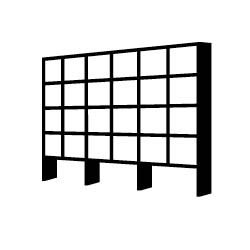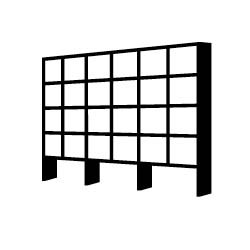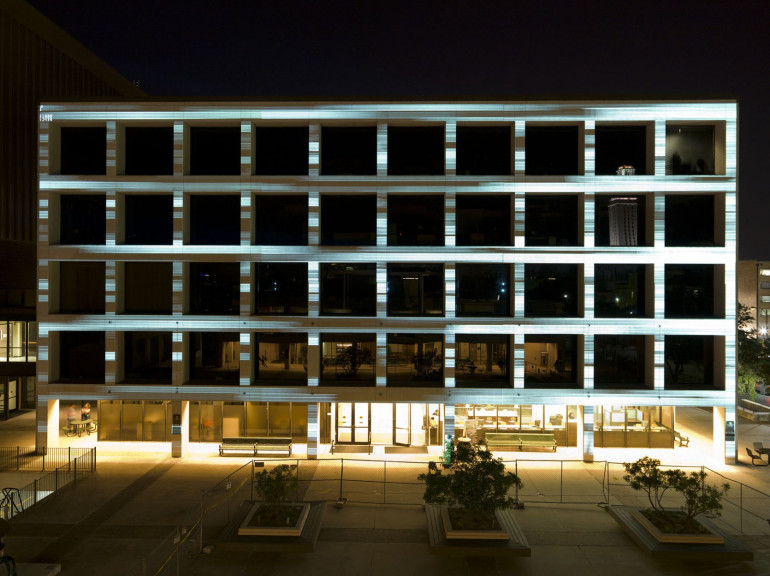And That's The Way It Is
Ben Rubin
Approximately 120 × 42 feet
Commission, Landmarks, The University of Texas at Austin, 2012
GPS: 30.289108,-97.740819
A pioneering figure in contemporary media art, Ben Rubin creates work that communicates patterns of information, thought, and language via electronic media. Whether conceiving a work of intimate or monumental scale, he composes algorithms and computational systems, often relying upon a selected data source to generate nonlinear results. The transformation of the familiar into the unexpected, captured through gracefully simplified forms, results in works that are quietly provocative and engage viewers as participants.
Visible every evening in the Walter Cronkite Plaza, And That’s The Way It Is projects an interwoven grid of text from two sources: closed caption transcripts of five live network news streams, and archival transcripts of CBS Evening News broadcasts from the Cronkite era (1962–1981) housed at the university’s Briscoe Center for American History. Rubin’s software scans for various patterns in speech and grammatical constructions, then selects sequences of text. The artist visually distinguishes these sources by using two typefaces that evoke the technologies of their respective eras: Courier represents the Cronkite material, and Verdana is used for the live broadcasts.
And That’s The Way It Is translates the spoken language of televised evening news into written fragments. The layering of information — textual and visual, contemporary and historical — engages the viewer cerebrally as a distilled source of information, and viscerally as a purely visual experience of luminescent crescendos and diminuendos. The speed and immediacy of live fragments heightens the viewer’s anticipation from one composition to the next, while the insertion of historical phrases activates a dialogue between the past and the present. Projected on an architectural scale, the work offers streams of language that suggest the activities transpiring behind the façade of the communication building.
ACTIVITY GUIDES

And That's The Way It Is
Ben Rubin
Subject: Patterns
Activity: Create repeating patterns within the grid lines
Materials: Paper, ruler, and drawing supplies (markers, crayons, or pencils)
Vocabulary: Symbol, pattern
A pattern is a decorative design that often repeats a series of symbols, images, words, letters, numbers, or any other shape. You can see patterns all around you everyday in pictures, in books, on clothing, or on buildings. Sometimes they are part of the basic design of an object. In this building, the windows are all the same size and shape, creating a repeating pattern across the building. Patterns can also be used in writing, especially in poems that rhyme.
This artist looked for patterns in speech from current and past news broadcasts and projected them onto the pattern of the building.
What patterns do you see on the building?
What patterns do you see in the projections?
Look at how the artist has responded to the patterns in the building with his projection.
Ask the child to create a grid similar to the building’s design on a piece of paper. (Or draw the grid for the child in advance.) Ask the child to pick a couple of symbols (images, shapes, colors, numbers, letters, etc.) and design a repetitive pattern to go into the grid of the building.
Symbol —A letter, character, or sign used instead of a word or group of words
Pattern —An artistic form, figure, or design

And That's The Way It Is
Ben Rubin
Subject: Responding to space
Activity: Partner drawing
Materials: Grid paper and drawing supplies (pencils, crayons, markers, etc.)
Vocabulary: Grid, projection
Ben Rubin is a visual artist who works with video projections. In this work, he combines text from current and past television news broadcasts, looking for patterns in speech and grammar. Many of Rubin's previous pieces follow a grid pattern, and this one uses the grid of the building as a frame. While in this piece he usually follows the grid to guide his projections, he also sometimes breaks out of the boundaries of the grid.
Where do you see Rubin responding to the grid?
How do you see Rubin breaking the boundaries of the grid?
On a sheet of paper, draw a grid similar to the building’s design. (These can be prepared in advance.) Using images, words, or both, create a design within the lines of the grid; don’t draw anything in the “window” spaces. When you’re done, trade drawings with a partner. On your partner’s sheet, extend their design into the window designs, but don’t draw anything on the grid.
Grid —A series of evenly spaced lines going across and up and down a surface
Projection —A film image reproduced on a surface

And That's The Way It Is
Ben Rubin
Subject: Patterns in newspaper headlines
Activity: Collage
Materials: Paper, scissors, glue, Internet access, and computer printer
Vocabulary: Collage, pattern
Ben Rubin is an artist who often creates artworks that isolate text from its original source. His previous works have presented text from Internet chat rooms (Listening Post, 2004) or from current and past issues of the New York Times (Moveable Type, 2007).
This piece combines text from current news broadcasts with older segments by Walter Cronkite for the CBS Evening News. Rubin’s software scans the text for patterns in speech and grammar and selects pieces to project, creating a conversation between past and present.
Can you tell which headlines are from today and which are from the Cronkite archives? How do you know?
What patterns do you see in the headlines projected?
Take a look at the headlines of a newspaper from today. Then look at the headlines from a thirty- to fifty-year-old newspaper. What patterns do you see? What has changed and what has stayed the same? Create a collage from the headlines highlighting the patterns you see.
Source for newspaper archives: http://texashistory.unt.edu/explore/collections/TDNP/browse/
Ben Rubin studied semiotics (the study of signs or symbols) and computer science in college.
Collage—A work of art created by pasting various materials onto a surface
Pattern —A collection of recurring events or objects
Semiotics —The study of signs and symbols
MORE INFORMATION
A sound designer and visual artist, Ben Rubin is a central figure in contemporary media art. He successfully interlaces the sonic with the visual, creating dynamic electronic works that engage the viewer in real time and space. Rubin’s work is concerned with communicating patterns of information, thought, and language via electronic media. With a background in computer science and semiotics (the study of signs and symbols and their use), Rubin creates diverse multisensory works that range from large-scale public projects to small, intimate environments.
Born in Boston in 1964, Rubin studied computer science and semiotics at Brown University and earned a master of science in visual studies from the Massachusetts Institute of Technology’s Media Lab. He studied under some of the great figures in documentary film, minimal music, and video art, including Richard Leacock, Steve Reich, and Beryl Korot. While at Brown, Rubin also studied film production with renowned cinematographer and documentarian John Terry at the Rhode Island School of Design. Applying his background in semiotics to the study of film, Rubin researched the theory behind film editing, exploring how computer programs might determine cinematic sequences. These investigations renewed his longstanding interest in the patterns of language—the interchangeable units, syntax, and grammatical structures that continue to inform his work.
Rubin’s grandfather, who worked as a classical DJ and impresario in Los Angeles during the 1940s, was among his earliest musical influences. With music as an important presence in his upbringing, Rubin developed a keen ear and sensitivity to rhythms and phrasing—skills that were further developed as a technical collaborator for composer Steve Reich’s and video artist Beryl Korot’s acclaimed multimedia opera, The Cave (1990–93). During those formative years, Rubin incorporated many of Reich’s notions regarding musical structures, phrasing, and repetition into his own audiovisual works.
Rooted in video art, performance, and even happenings, Rubin’s contemporary work realizes the artistic potential of electronic media. During the late 1950s and early 1960s, artists Wolf Vostell and Nam June Paik were among the first artists to incorporate televisions into their installations, thereby using televisual technology and new means of communication as sources for creative expression. Moreover, the interaction between the body and its surrounding space in Rubin’s work recalls Allan Kaprow’s happenings, in which the viewer’s participation and immediacy are essential. Privileging rhythm and nonlinearity over tonality, while also incorporating the element of chance, John Cage’s body of work also serves as an important precedent for Rubin’s own new media work.
Soundplay (1993) is an early example of Rubin’s engagement with multisensory, responsive environments. In the installation, the visitor stands on a small platform connected to a computer program. The interactive piece translates the visitor’s movements into sound—a contracted muscle or slight twist of the torso results in sonic feedback. By translating bodily tension or motion into projected audio, the work heightens the participant’s awareness of his/her body as an instrument in the environment.
In 1993 Rubin founded the New York–based EAR (Electronic Arts Research) Studio, a collaborative work environment that has realized projects with Ann Hamilton, Diller + Scofidio/Renfro, Renzo Piano, Bruno Latour, and Laurie Anderson. Rubin and his longtime collaborator Mark Hansen gained notoriety for the project Listening Post (2002), for which they received the Ars Electronica Golden Nica Prize in 2004.
Listening Post is an audiovisual installation that presents strings of text from live chat rooms. Participants converse online, unaware that Rubin and Hansen have used computer software to mine data from their interactions in order to recontextualize their words. The data is organized into a series of six choreographed “scenes,” analogous to the movements of a symphony. Text fragments from the chats stream across a suspended grid of more than two hundred small LED screens, while a voice synthesizer simultaneously reads the text aloud. Infinite permutations based on real-time data result from the controlled system, generating a sense of immediacy for the viewer while raising questions about authorship and privacy.
Whether creating a work of intimate or monumental scale, Rubin begins by constructing parameters to convey patterns of thought or behavior. He composes algorithms and computational systems, often relying upon a selected data source to generate nonlinear results. The transformation of the familiar into the unexpected, captured through gracefully simplified forms, results in works that are quietly provocative and that gently turn viewer into participant.
And That’s The Way It Is
Visible every evening in the Walter Cronkite Plaza, And That’s The Way It Is projects an interwoven grid of text from televised news broadcasts. Rubin’s own software, which scans for various patterns in speech and grammatical constructions, selects the sequences of text. The work acquires its content from two sources: closed caption transcripts of live network news and archival transcripts of CBS Evening News broadcasts during the Cronkite era, including those housed at the university’s Briscoe Center for American History. Rubin visually distinguishes these sources by using two typefaces that evoke the technologies of their respective eras. Courier, a monospaced font developed for IBM’s line of electric typewriters, represents the Cronkite material. For the live broadcasts Rubin uses Verdana, a digital typeface originally designed for its legibility on a computer screen.
The light projection weaves a tapestry of information into two- to three-minute scenes, each of which has its own compositional rhythm, visual presentation, and internal logic. Projected on an architectural scale, the work offers streams of language that suggest the media-based activities transpiring inside the communication building. To realize the installation, Rubin worked closely with his EAR Studio collaborators, including architect Michele Gorman, data artist Jer Thorp, and statistician Mark Hansen.
And That’s The Way It Is translates the spoken language of televised evening news into written fragments. Borrowed words and phrases underscore familiar media devices and readily trigger personal associations with newsworthy events. Shifting sensory input from the aural to the visual, Rubin thereby presents televised news in ways that are altogether new. The layering of information—textual and visual, contemporary and historical, immediate and distant—evokes an awareness of current news trends and intellectual patterns. Thus, the work engages the viewer in multiple ways: cerebrally, as a distilled source of information, or viscerally, as a purely visual experience of luminescent crescendos and decrescendos. The speed and immediacy of real-time fragments heightens the viewer’s anticipation from one composition to the next, while the insertion of historical phrases activates a dialogue between the past and the present. The motion and cadence as well as the rise and fall of movement and thought presents endless discovery in the new, tempered by evocations of the past.
Lauren Hanson is a doctoral candidate in Art History at The University of Texas at Austin, specializing in 20th-Century European and American Art. Her research interests include exhibition practices post-1945, memory and artistic practice, constructions of artistic identities, and intersections of art and politics. She is currently completing her dissertation, Creating a Scene: Art and Experimentation in Düsseldorf circa 1958, which addresses how a network of artists, curators, and critics navigated the post-war environment in West Germany.
Bullivant, Lucy. Responsive Environments: Architecture, Art and Design. London: V&A Publications, 2006.
Donoff, Elizabeth. “Media Artist Ben Rubin Explores the Interaction between Light, Sound and Symbol.” Architectural Lighting Magazine, January 2007, 26–29.
Gladstone, Brooke. “Moveable Type.” On the Media. National Public Radio, 30 May 2008.
Hansen, Mark, and Ben Rubin. “Listening Post: Giving Voice to Online Communication.” Proceedings of the 2002 International Conference on Auditory Display, Kyoto, Japan, 02-05 July 2002.
Kennedy, Randy. “New Flows, Consciousness Streams: The Headwaters of a River of Words.” New York Times, 25 October 2007, E5.
Rubin, Ben. “Dark Source.” In Making Things Public: Atmospheres of Democracy, edited by Bruno Latour and Peter Weibel. Cambridge: MIT Press, 2005.
Shanken, Edward A. Art and Electronic Media. London: Phaidon, 2009.
Landmarks commissioned Ben Rubin to create a project for the College of Communication’s Belo Center for New Media. Rubin’s new media installation, And That’s The Way It Is, was unveiled in April 2012 at the dedication of the Walter Cronkite Plaza in honor of Walter Cronkite. And That’s The Way It Is consists of an evolving stream of text vignettes projected on the southern façade of the CMA building.
The project was funded through the College of Communication’s capital improvement project. It can be viewed every evening from dusk until midnight in the Walter Cronkite Plaza, located on Whitis Avenue, between 25th and Dean Keeton Streets.
For their support and assistance, Landmarks would like to thank:
Leadership
Andrée Bober and Landmarks
Pat Clubb and University Operations
Douglas Dempster and the College of Fine Arts
Roderick Hart and the Moody College of Communication
Landmarks Advisory Committee
William Powers and the Office of the President
Bob Rawski and the Office of Facilities Planning and Construction
David Rea and the Office of Campus Planning and Facilities Management
Bill Throop and Project Management and Construction Services
Sharon Wood and the Faculty Building Advisory Committee
Project Team
Andrée Bober, curator and director, Landmarks
Pawn Chavaltur, Office of Facilities Planning and Construction
Dennis Duff, Project Management and Construction Services
Michelle Gorman, EAR Studio
Bill Haddad, Landmarks
Severine Halls, Office of Facilities Planning and Construction
Mark Hanson, EAR Studio
Nisa Mason, project manager, Landmarks
Ben Rubin, artist
Jer Thorpe, EAR Studio
Special Thanks
Bryce Wolkowitz Gallery
Don Carleton and the Dolph Briscoe Center for American History
Janice Damon, Moody College of Communication
Andrew Dillon and the School of Information
Kathleen Forde, curatorial contributor
Leag Griffin, education and external affairs, Landmarks
Lauren Hanson, curatorial contributor
Thomas Lekometros, Earl Swisher, and Lawrence Group Architects
Stephen Littrell and University of Texas Libraries
Beth Palazzolo, administrative coordination, University Operations
Frank Serpas, Moody College of Communication
Stephanie Taparauskas, event coordination
Texas Student Media


